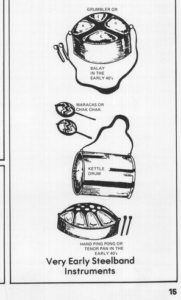1930/1940 - Early Steelpan History – In A Nutshell
____ ARTICLE IS UNDER CONSTANT REVISION___
Be engaged to mail feedback to: contact@handpan-timeline.org
Early Steelpan:
From convex to concave
- “There are many conflicting claims about who first discoveres that dents on an old biscuit tin could produce musical notes when struck, and thereafter succeeded in beating out a simple melody on it. Maybe it was a synchronicity, a happening involving more than one person over a particular period or moment in time – the real catalyst being the historical, cultural and sociological circumstances”
Ry Grant, Ring of Steel- Pan Sound and Symbol. 1999, page 11.
“The surface of Spree Simon’s pan, on which the notws where placed, bulged outward into a convex shape.” Ry Grant, page 18
- “This man (…) he had a garbage can cover that had some convex rims he could get tones from the different part of the rims – he got this bright idea that if he were to get a pan and get out certain sections, he would be able to produce different notes from different sections. And this man was the pioneer – Winston ‘Spree’ Simon. (…) From there somebody else got a few more notes and someboy else got the bright idea too instead of turning it out (convex) this man tuned it in (concave). (…)And we used to play the ‘biscuit’ drums with our hands (…)
Source: “Pan and Carribbean Drum Rhytms – by Mackie Burnette” , Jamaica Journal, 1978, Vol11 . Full article: https://www.dloc.com/UF00090030/00032/18?search=jamaica+%3djournal%2cjamaica+%3djournal

___
- “Ellie Mannette (5. November 1926) also known to many as the Father of the Modern Pan (…) is credited with being the first to wrap the playing sticks with rubber (…). He was also the first to sink the surface of a pan into its now characteristic concave shape which allowed for more pitches to be placed (…).” Source: “Ping Pong – The evolution of Steelpan in Trinidad and Tobago”, 2020, Kezel Jackson, Page 20
___ “(…)Mannette, who always had an interest in metals and machine-shop work, observed other bands and performers such as Winston “Spree” Simon producing tonal qualities on biscuit tins. Simon played “Mary Had a Little Lamb” and “River Vine Vine” on his small drum. Mannette was fascinated with the ability to produce four or five concave pitches from a convex surface and tried to replicate the sounds himself.”
Source: Percussive ARTS Society, PAS Hall of Fame, Elliott “Ellie” Mannette, by Lisa Rogers
https://www.pas.org/about/hall-of-fame/elliott-ellie-mannette
___- “He (Ellie Mannette) fashioned drums out of 55-gallon barrels and made them concave, like a bowl, which gave them a different sound. He tuned the instruments by ear”
Source: https://www.nytimes.com/2018/08/31/obituaries/ellie-mannette-dead.html
___
- “During this period (the early 1940’s) , there were innovations such as the Ping Pong, Tenor Kittle with five notes, Grundig, Cuff Boom, the Dudup and the Bass Kittle. The rest of the decade saw a trementous spontaneous surge in the development of the instrument. The sweet-oil drum, formed in convex profile with five to seven notes (the original ping pong), held up in one hand, and played with a rubber-less stick in the other, gave way to the instrument made from an oil drum formed in concave profile, originally with about fifteen notes played with rubber-tipped sticks.”
Source: Trinidad and Tobago Bureau of Standards http://kalipa.gottbs.com/embed_gen/index.php?doc=2019-04-23-82874TTS%20412-2015%20Standard%20for%20Steelpan.pdf
___
- “The 1st musical steel pan was a convex dome with 4 notes dented into the surface. The initial sound was rough and gritty, very different from the clear tones of the modern pan.”
Source: http://andrewsalamanca.com/author/andrewsalamanca/page/3/

___
- “The very first steel drums with pitches(notes)were made from smaller metal containers and were convex in shape.”
Source: www.caribbean-steel-drums.com/steel-drums.html
___
- “The ping pong was a small hand held pan made from a biscuit tin to provide rhythmic music for pleasure during the early 1930’s. `”
Source: http://mypanyard.co.uk/History-ping-pong.html

- “The ping pong was a forerunner to the tenor pan. When the ping pong was struck with woodden sticks, small bumps were formed upwards which were then tuned to diffreent pitch notes.”
Source: “Ping Pong – The evolution of steelpan in Trinidad and Tobago”, 2020, Page 12
___
- “Some ideas included the reconceptualization of the layout of individual notes on the instrument to a chromatic and versatile playing surface, as well as transforming the surface of the drum from a convex to a concave product. In an attempt to develop the instrument, they began to stretch the surface inward instead of outward.”
- “Mannette is credited for sinking the face of the drum to a concave shape in contrast to a convex one, which he claims to have accomplished in 1941 during an interview.”
- “The first ping pongs had their faces pounded out in a convex dome and had only two or three notes, not necessarily well defined in pitch.”
Source for this 3 quotes: “The History of the Steelpan, it’s impact in Hartford and the significant evolution” / 2019. Trinity College. https://digitalrepository.trincoll.edu/cgi/viewcontent.cgi?article=1819&context=theses
___
- “The drums at that time was convex. (…) The top of the drum – the surface – was kind of a globe” – Ellie Mannette speaking about early steelpan. Source: “Ellie Mannette- Father of the modern Steelpan” Short-Documentary, min 2:08
https://youtu.be/23Bp59xfAUw?t=128
___
- “Instead of sinking it concave they were pushing it convex (…)” Dudley Dickson (Pan Tuner)
Source: “The Steel Pan” Documentary (2010) (min 6:20)
https://youtu.be/5vr2-l2VKzw?t=376
___
- „About the early pans being convex (upward) like the Hang.“
Dr. Achong sums up: „The Hang is a steelpan (pan) having limited musical range (…)“
https://handpan-timeline.org/timeline/dr-achong-hang/
______
- Virtual Museum Tour: Min.5: MIM curator Daniel Piper about Winston Spree Simon and convex Pans.
___
- “Developments (1945-1950)
sweet-oil drums (ping pong) sunk in convex fashion
5 to 7 notes
drums held in one hand, rubberless stick in other
oil drum sunk in concave fashion
15 notes with rubber-tipped sticks
competitions begin in Port of Spain & San Fernando
notes continue to be added to drums/instruments”
Source: https://www.panonthenet.com/history/panhist.htm
- “1939- Sweet-oil pans, dust bins, biscuit pans: convex – shape”
Source: http://www.trinicenter.com/steelpan/briefhistory.htm
TRIVIA
“Panomundo” Documentary (2016)
Description: https://pan-mag.com/documentary-review-panomundo-parts-1-and-2/
Steelpan Documentary “Pan Fusion” (1997)
“Ellie Mannette- Father of the modern Steelpan” Short-Documentary (~2min)
“Bertie Marshal – The Steel Pan Visionary” – Documentary by Dalton Narine
“A Brief History of Steelpan”
Documentary – “How to make Steel Drums 1956” (Remastered) (~2:30min)
“The Steelpan became the national musical instrument of the Republic of Trinidad and Tobago on the 30th. August 1992”
Source: Trinidad and Tobago Bureau of Standards http://kalipa.gottbs.com/embed_gen/index.php?doc=2019-04-23-82874TTS%20412-2015%20Standard%20for%20Steelpan.pdf
More Links
A brief history of the steel pan, 2012, BBC
https://www.bbc.com/news/magazine-18903131
“From Dustbins to the Classics” Lennox Pierre, 1962
http://www.seetobago.org/trinidad/pan/goddard/ggtx01af.htm
More literature-collections
http://www.pan-jumbie.com/history-research/
http://www.stockholmsteelband.se/pan/tuning/preface.php
https://weteachpan.org/resource/pan-thesisdissertation-index/

